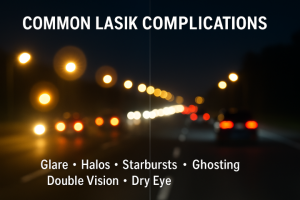One of the most troubling truths about LASIK is that many people who were never good candidates were still approved for surgery. Conditions that should have raised immediate red flags were ignored or overlooked, including:
-
Large pupils – leading to severe glare and halos, especially at night.
-
Dry eye disease – often worsened permanently by LASIK.
-
Keratoconus and other corneal irregularities – conditions that LASIK should never be performed on.
When these issues go undiagnosed, LASIK doesn’t just fail—it often exacerbates underlying problems, creating complications that patients may live with for the rest of their lives.
Our founding doctors were heavily involved in many ophthalmic studies, as well as pre- and post-operative care when LASIK was first introduced. At the time, LASIK was promoted as a revolutionary procedure that would free people from glasses forever.
But as time went on, the reality became clear. Too many patients were experiencing complications that didn’t go away. Our practice quickly shifted its focus to helping these patients—people who were left without answers, struggling to see and function. For the past 25 years, our work has been dedicated to understanding, treating, and helping patients manage LASIK complications.
We do not perform LASIK surgery. Our mission is to help those who are suffering from its consequences.
Every day, we work with patients suffering from:

For many patients, these complications appear immediately after surgery. For others, they emerge years later as the cornea continues to weaken or change.
When patients complain of poor results, many are told that the solution is a “touch-up” or additional LASIK procedure. Unfortunately, these follow-ups often make things worse—removing even more corneal tissue and further destabilizing the eye.
We’ve seen countless patients who came to us only after multiple surgeries left them with vision far worse than before. If you are considering a LASIK touch-up, please pause and seek an independent evaluation.
If you’re struggling after LASIK, don’t give up hope—even if you’ve already tried scleral lenses or have been told that you need a corneal transplant.
We utilize the most advanced imaging and analysis tools available to design lenses that restore functional vision, even for the most complex post-LASIK cases. By combining these technologies, we often achieve results that go far beyond standard scleral lenses:
-
Pentacam Corneal Mapping – 3D analysis of the cornea to detect irregularities.
-
OCT (Optical Coherence Tomography) – high-resolution imaging of corneal layers and fit evaluation.
-
Wavefront Aberrometry & HOA Testing – measures higher-order aberrations causing glare, halos, and distortion.
-
Custom Impression-Based & HOA-Correcting Lenses – uniquely designed scleral lenses providing exceptional clarity and comfort, even for highly irregular corneas damaged by LASIK.
The result? Sharper, more natural vision and renewed independence. You can read powerful patient stories on our Post-LASIK Testimonials page.


